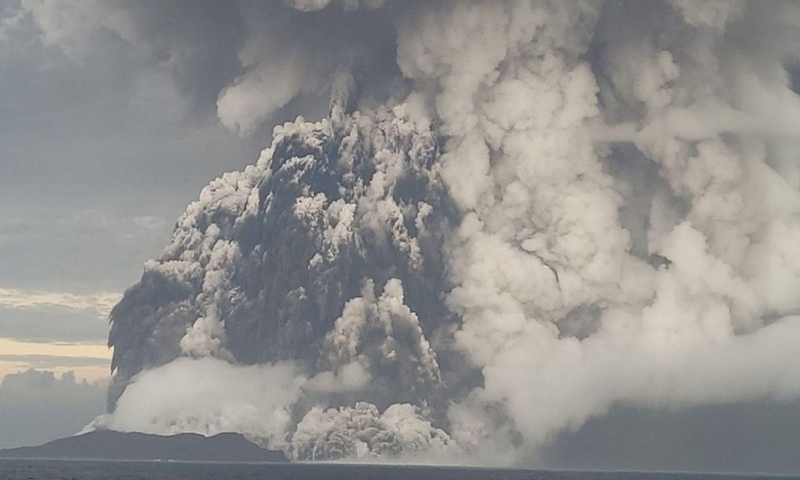
Photo taken on Jan.14, 2022 shows the eruption of Hunga Tonga-Hunga Ha'apai volcano in Tonga.(Photo Tonga Geological Services of the Government of Tonga/Xinhua)
As international disaster relief efforts are still underway in Tonga after a massive volcanic eruption and a powerful tsunami that has killed at least three people, resumption of communications has become a priority, in which Chinese telecommunications could offer much-needed assistance, analysts said.
Huawei Philippines, which is responsible for operations in Tonga, also said on Tuesday that the company is now able to communicate with its Tongan partners by satellite phones, China Media Group reported on Wednesday.
A slew of Chinese companies and technologies such as drones could come in handy in helping Tonga restore communications, including helping repair an undersea cable that connects the country with the rest of the world, Chinese analysts noted.
The main difficulties in restoring communications are the unknown situation, unstable or inadequate power supply and unreliable transportation, Ma Jihua, a veteran telecommunications industry analyst, told the Global Times on Wednesday.
"In emergency situations, small base stations can be built first and directly connected with satellites to ensure basic emergency voice calls. Now, temporary base stations can be provided by long-endurance unmanned aerial vehicles (UAV)," Ma said.
China's self-developed UAV Wing Loong drone
was deployed to restore communications in Central China's Henan Province in July 2021, after network signal was cut off by record downpours and floods. The drone traveled around 1,200 kilometers in four and a half hours to arrive in the targeted area, and it operated for eight hours there.
"Satellite signals are expected to support international calls from Tonga in a day or two," Xiang Ligang, an independent tech analyst, told the Global Times on Wednesday.
Satellite communications in Tonga may be running in the next few days and the nation is halfway to connecting satellite communication, Tonga's speaker of Parliament told the media on Tuesday.
Xiang noted that satellite communication, which is expensive, can support urgent phone calls and text messages, but for photo and video transmission that needs broadband, Tonga's communication will still rely on the submarine cable.
The natural disaster has damaged the Tonga-Fiji Submarine Cable Project, which is the only cable that links Tonga to Fiji, where an existing international submarine cable system provides access to the rest of the world, according to the completion report from the Asian Development Bank, which financed the project.
Australia, via the Pacific Regional Infrastructure Facility (PRIF), provided substantial technical assistance to the Tonga Ministry of Meteorology, Environment, Information, Disaster Management, Climate Change and Communications, albeit outside the project, read the report.
According to TeleGeography's submarine cable map, Tonga's undersea cable goes through Fiji and all the way to Australia, New Zealand, Vanuatu, New Caledonia, and Hawaii and American Samoa of the US.
It will take at least two to four weeks to repair the cable, and ships are finding it difficult to approach, media reports said.
Restoring communications will require operators to work with equipment vendors to overhaul optical cables and base station equipment. Equipment suppliers need to have emergency spare parts for maintenance, said Ma.
Industry sources said that Chinese firms are capable of helping with the renovation of the submarine cable. Other high-tech devices, like unmanned boats and remote water supply systems, can help with the rescue work.
The Red Cross in Tonga on Wednesday confirmed an urgent need for safe drinking water, with supplies disrupted by layers of volcanic ash.
WHO spokesperson Christian Lindmeier told reporters on Tuesday that Tongatapu, the main island of Tonga, is covered with about 2 centimeters of volcanic dust and ash, raising concerns of air, water and food pollution.




